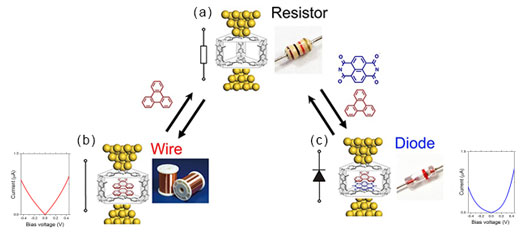| Posted: Jul 21, 2015 |
Self-assembled aromatic molecular stacks, towards modular molecular electronic components
|
|
(Nanowerk News) Being able to effectively tune the electron-transport properties of a single-molecule has been a long-standing issue towards the crystallization of molecular electronics, where individual molecules mimic the behavior of common electronic components as a true alternative to conventional silicon devices. To functionalize electron transport properties, each and every individual molecule must be precisely aligned in place with sub-nanometer precision. In that sense, stacks of self-assembled aromatic components in which non-covalently bound -stacks act as replaceable modular components are promising building blocks.
|
|
Here ("Rectifying electron-transport properties through stacks of aromatic molecules inserted into a self-assembled cage"), researchers describe the electron-transport properties of aromatic stacks aligned in a self-assembled cage, using a scanning tunneling microscope (STM) based break-junction method.
|
 |
| Schematic illustration of single molecule-junctions consisting stacks of aromatic molecules in a self-assembled cage and the corresponding electronic components of the junctions. The assembled cage is sandwiched by two Au electrodes. Empty cage (a), homo-stacks and hetero-stacked pair (c) develop functions of resistor, wire and diode, respectively.
|
|
Both identical and different modular aromatic pairs are non-covalently bound and stacked within the molecular scaffold leading to a variety of fascinating electronic functions. The empty cage presents a low electronic conductance (10–5 G0) characteristic of resistors (Figure a) while the insertion of identical molecular pairs results in a marked conductance increase (10–3–10–2 G0, G0 = 2e2/h) mimicking the behavior of electronic wires (Figure b). On the contrary, when different molecular pairs are inserted into the scaffold, electronic rectification (rectification ratio 2-10) characteristic of a diode can be observed (Figure c).
|
|
Theoretical calculations demonstrate that this rectification behavior originates from the different stacking order of the internal aromatic components with respect to the direction of the electron-transport, and the corresponding lowest unoccupied molecular orbital conduction channels localized on one side of the molecular junctions.
|
|
This study paves the way for the development of molecular electronic devices with tunable electronic functions.
|

